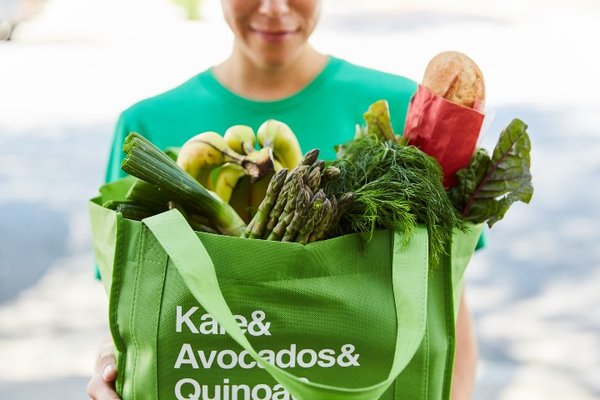Demand for food delivery services has exploded in the last several years. Following the post-pandemic recovery, consumers have become increasingly accustomed to the convenience and ease of food delivery apps from restaurants and retailers alike. While the market for food delivery services has skyrocketed, transforming that demand into profits has been difficult for some companies. Others have increasingly refined their business models, growing revenue and profits steadily.

Top food delivery stocks in 2025
Top food delivery stocks in 2025
Here’s a closer look at these top food delivery stocks:
| Name and ticker | Current price | Market cap | Sector |
|---|---|---|---|
| DoorDash (NASDAQ:DASH) | $179.56 | $75 billion | Consumer Discretionary |
| Uber Technologies (NYSE:UBER) | $73.03 | $153 billion | Industrials |
| Domino's Pizza (NASDAQ:DPZ) | $462.78 | $16 billion | Consumer Discretionary |
| Target (NYSE:TGT) | $90.60 | $41 billion | Consumer Discretionary |
| Walmart (NYSE:WMT) | $91.20 | $731 billion | Consumer Staples |
| Instacart (NASDAQ:CART) | $42.10 | $11 billion | Consumer Staples |
1. DoorDash
1. DoorDash
DoorDash is the leading third-party food delivery service in the U.S., with a market share of roughly 67%. If you order from a restaurant that doesn’t offer deliver itself, there’s a good chance DoorDash will bring your meal.
DoorDash primarily makes money through commissions from restaurants on each order, delivery fees charged to customers, subscription fees for DashPass, and advertising revenue. In the fourth quarter of 2024, DoorDash reported that total orders increased 19% year over year to 685 million, and marketplace gross order value increased 21% year over year to $21.3 billion.
The company's Q4 revenue rose 25% from one year ago to $2.9 billion. It also reported a net income of $141 million compared to a net loss of $154 million in the same quarter the prior year. Looking at fiscal 2024 on the whole, revenue increased 24% to $10.7 billion, while net income totaled $117 million for the 12-month period.
If you want portfolio exposure to the third-party restaurant delivery business, then DoorDash could be a stock worth owning.
2. Uber
2. Uber
Ride-share giant Uber doubled down on restaurant food delivery during the pandemic, bolstering its Uber Eats service with numerous acquisitions, including the food delivery service Postmates and super-app Careem. Soaring demand for food delivery helped offset tumbling demand for mobility services, but both businesses are now showing strong growth.
In Q4 2024, Uber's gross bookings unit grew 18% year over year to $44.2 billion, with mobility gross bookings of $22.8 billion (up 18% year over year) and delivery gross bookings of $20.1 billion (also up 18%). Revenue increased 20% from one year ago to $12 billion, while combined mobility and delivery revenue rose 23% to $10.7 billion.
Uber also reported a net income of $6.9 billion in the final three months of 2024, with income from operations of $770 million. Revenue for the entire fiscal 2024 came to just shy of $44 billion, an 18% increase, with profits of $9.9 billion. The company is cash flow-positive, with Q4 free cash flow totaling $1.7 billion. Uber stock is a solid choice for investors who want portfolio exposure to both food delivery and passenger transportation.
3. Domino’s Pizza
3. Domino’s Pizza
Fast-food pizza chain Domino’s has its own well-established food delivery infrastructure. Not relying entirely on third-party delivery partners saves the company money in fees and gives it complete control over the delivery process and the customer experience. For a long time, Domino's was known for its resistance to third-party delivery apps, preferring to control the delivery experience with its own drivers.
However, they reversed course in 2023, recognizing the potential of third-party platforms to reach new customers and increase sales. Domino's initially partnered exclusively with Uber Eats through May 1, 2025. This allowed customers to order Domino's through the Uber Eats and Postmates apps, with delivery handled by Domino's and its franchisees.
Domino's has since started negotiating with other third-party delivery services, testing partners in select areas of the country, which suggests they will no longer be solely reliant on Uber Eats.
Domino's operates primarily as a franchiser, with franchisees owning and operating the majority of the stores. The company earns revenue from franchise fees and royalties paid by these owners. The company also generates substantial revenue from its supply chain operations, which includes distributing ingredients and equipment to franchisees. In fiscal 2024, Domino's reported total revenue of $4.7 billion, a 5.1% increase from the prior year. Net income totaled $584.2 million, up 12.5% year over year.
The strength of the company’s franchise model and supply chain business is enduring competitive advantage. Investing in Domino’s stock is a good bet if you want to own part of a restaurant delivery company that already generates a healthy profit.
4. Target
4. Target
In addition to traditional takeout, grocery delivery has increased in popularity, and Target has been one of the trend's beneficiaries. Since acquiring the delivery service Shipt in 2017, Target now offers both delivery and pickup options, including a Target Circle 360 delivery membership and one-time deliveries for a fee.
Target is currently facing numerous challenges, such as a shift in consumer spending toward essentials and value-focused retailers, plus rising costs, which have led to sluggish sales and profits in recent years. However, the company is still profitable and has a robust omnichannel platform that could serve it well in the long run.
Target's Q4 2024 comparable sales rose 1.5% from the year-ago period, while digital comparable sales grew 8.7%. Same-day delivery was a robust area of growth for Target, and this business grew more than 25% in Q4 2024 compared to the same quarter in 2023. Full-year net sales decreased 0.8% to $106.6 billion, but reflected a 0.1% increase in comparable sales. Net earnings were $4.1 billion for the 12-month period.
5. Walmart
5. Walmart
Since piloting the program in 2013, Walmart's grocery pickup services have grown in popularity. The introduction of the the retailer's Walmart+ membership program in 2020 has further boosted revenues from grocery delivery. For a monthly fee, Walmart+ members can order same-day delivery of groceries, consumer staples, and general merchandise, along with additional perks. Walmart uses third-party services for delivery, so it doesn't handle the deliveries directly.
For consumers who value the convenience and low prices for which Walmart is famous, the company’s grocery delivery services will likely continue to be popular. In 2024 (Walmart's fiscal 2025), the company reported revenue of $681 billion, up 5.1% from the prior year. The value-focused retailer significantly expanded its U.S. store-fulfilled delivery areas in Q4, and it can now reach 93% of U.S. households with same-day delivery. Walmart also reported an operating income of $29 billion, an increase of 8.6% from the prior fiscal year.
Related investing topics
6. Instacart
6. Instacart
Instacart became a publicly traded company in 2023. Launched in 2012, the platform primarily makes money through customer delivery fees, service fees, and Instacart Express membership fees, as well as commissions charged to grocery stores.
Instacart partners with a wide variety of retailers, including supermarkets, pharmacies, pet stores, and more. Customers use the Instacart app or website to browse stores and add items to their carts. Instacart then connects customers with a personal shopper in their area to shop and deliver the orders.
Customers can choose same-day delivery or schedule a delivery for a later time. Shoppers can shop and deliver items to customers' homes or prepare them for pickup at the store. Instacart charges a service fee on every order, which can vary based on factors like the customer's region and the number of items in their cart.
Delivery fees also apply and may differ depending on order size, delivery time, and distance. Advertising is another revenue driver, as the company is actively expanding its retail media business and advertiser base.
In 2024, Instacart recorded a gross transaction volume of $33.4 billion on the platform, up 10% year over year. Orders reached 294 million, up 9% year over year. while total revenue rose 11% to $3.4 billion. The company also reported a net income of $457 million, compared to a net loss of $1.6 billion in 2023.















